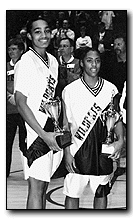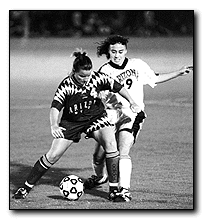![]()
![[ NEWS ]](/images/fall97/newsf97.gif)
![]()
By Kristen Davis
Arizona Daily Wildcat February 5, 1998
Making the Grade
![[Picture]](01_1_i.gif)
Wildcat File Photo Members of the 1996 NCAA softball championship team give high fives to their opposition after a game earlier that season. |
Despite Title IX, a 25-year-old law prohibiting gender-based discrimination
in schools, colleges - including the UA - are still treating their male
athletes better than their female counterparts, according to figures from
a study released in June.
The report, "The Women's Sports Foundation Gender Equity Report Card: A Survey of Athletic Opportunity in Higher Education," which was released to coincide with the 25th anniversary of Title IX, studied how resources among 767 Division I, II and III universities were divided during the 1995-96 academic year.
"American colleges and universities appear to be more strongly committed to meeting the needs of and interests of male athletes than female athletes," said WSF Trustee Don Sabo, a sociology professor at D'Youville College in Buffalo, N.Y.
USA Today in March also released a comprehensive look at equity, which was mirrored by the WSF study.

Wildcat File Photo UA senior center Marte Alexander (42) and senior guard DeAngela Minter (32) were selected to the All-Tournament Team at the Insight Women's Classic in December. |
As people gather in Washington, D.C., today to celebrate the 12th annual National Girls and Women in Sports Day, the increased awareness from studies such as the WSF and USA Today report are long overdue, said Kathleen "Rocky" LaRose, a UA senior athletic director.
The WSF issued four grades to each institution based on its effort to comply with the law, before arriving at an overall grade point average. The University of Arizona, a member of Division I, received a comprehensive mark of 2.40 for a B minus. The 103 Division I schools researched averaged 2.48.
The four study areas were athletic participation, scholarship allocations, recruitment spending and operating expenditures.
During the 1995-96 year, 41.78 percent of UA's athletic scholarships went to females. In recruiting costs, the Athletic Department spent 25.71 percent on women and 74.29 percent on men.
Women received 15.64 percent of UA's total budget, according to the WSF report.
"I don't know where they got those numbers. I don't think we're that low. I think the thing there is that's just something we need to keep working on," UA Athletic Director Jim Livengood said. "It doesn't mean that it's ever going to exactly mirror that, because your squad sizes are going to be so different.
"I think from our standpoint I think it's better. I don't think it's where it needs to be yet, but I think it's better, yeah."
John Perrin, senior associate athletic director at the UA, said Arizona's total budget is comprised of men and women's expenses as well as support services. Of the $23.05 million total budget for 1995-96, about $9.7 million was spent on men, about $3.37 million on women and about $10 million on support services.
LaRose, who helps monitor Title IX compliance, said it is difficult to look at figures to determine a school's gender equity climate.
For example, she said, it costs more than $1,000 to outfit a football player with the best equipment possible. A volleyball player, however, only needs a pair of knee pads.

Wildcat File Photo UA freshman forward Elena Galvan (19) makes a play to steal the ball from an ASU player eariler in the year. |
"But they're both getting the same equitable treatment, so when you look at the budget then in those terms, it's going to appear that we're spending less on our women's programs when we're not. We're still giving them the top of the line equipment," she said.
The survey's final area examined athletic participation, which is similar to the Department of Education Office for Civil Rights' "substantial proportionality" test. The civil rights office has not specified what is substantially proportionate, but the WSF issued an A to schools whose female athletic participation exceeded or came within five percentage points of its total female undergraduate enrollment.
While 51.17 percent of UA's undergrads were female during the 1995-96 year, 37.96 percent of the college athletes were women, according to the WSF study, corresponding to a B grade for its 13.21 percentage point difference.
Figures obtained from the Athletic Department's historical data were slightly different, indicating a 12.3 percent gap during that academic year. The Athletic Department's most current figures show a 12.1 percent difference during the 1996-97 year.
Of the 103 Division I schools the WSF researched, 94 of them did not meet the "substantial proportionality" criterion.
"I definitely know that there are ways in which we can reallocate funds to ensure that we're (more) fair and equitable to men and women," LaRose said. "That's really what the U of A Department of Athletics has been doing over the last several years now."
The percentage of scholarship dollars the UA awarded to women rose .77 percent between 1995-96 and 1996-97, but the percentage of the total athletic recruitment money spent for women's teams declined 1.11 percent over the same period.
To increase the school's "substantial proportionality," the UA is developing a plan to impose set squad sizes for men's teams beginning in the fall.
"We don't want to drastically affect any of our men's programs - what we would be looking at is cutting back on the walk-ons," said LaRose, adding that UA continues to encourage women's coaches to add walk-ons.
Another way Arizona is planning to increase women's participation is by adding another sport that could begin competing in the 2002-03 academic year.
Livengood said that in all likelihood, either water polo or lacrosse would be added. Synchronized swimming is also a possibility.
"Accountability always leads, I think, to progressive action, and so I think those are all very good things," LaRose said.
Arizona's Title IX report card
% Females Enrolled 51.17
% Female Athletes 37.96
Grade: B
% Scholarship 41.78
Grade: B+
% Recruitment 25.71
Grade: C
% Budget 15.64
Grade: D+
UA's "GPA"/Grade 2.40/B-
Division I Average "GPA": 2.48
Pacific 10 Average "GPA": 2.61
Highest Pac-10 Grade: Washington St. at 3.18 for a B+
Lowest Pac-10 Grade: Southern Cal at 2.00 for a C
Arizona's standing: Eighth lowest "GPA" in the conference
Source: 1997 Women's Sports Foundation Gender Equity Report Card, which obtained data from schools' 1995-96 academic year.



